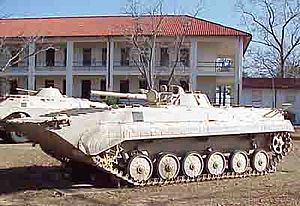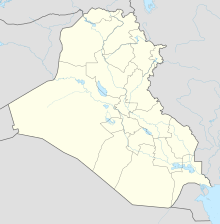| Battle of Rumaila | |||||||
|---|---|---|---|---|---|---|---|
| Part of the Gulf War (aftermath) | |||||||
 Armored vehicles captured in the Euphrates Valley of Iraq presented to the United States Army Infantry School by the 24th Infantry Division (Mechanized) in 1991 | |||||||
| |||||||
| Belligerents | |||||||
|
|
| ||||||
| Commanders and leaders | |||||||
|
|
| ||||||
| Units involved | |||||||
|
|
| ||||||
| Strength | |||||||
|
25,000 troops 241 M1 Abrams tanks 221 M2 Bradley armored fighting vehicles 94 helicopters[1] |
Estimated 7,000 troops[2] 300 tanks[2] 700 wheeled vehicles[3] | ||||||
| Casualties and losses | |||||||
|
1 wounded 1 M1 Abrams tank destroyed 1 IFV destroyed |
700+ killed[4] 3,000 captured[5] 247-360 tanks & armoured vehicles destroyed[5] 400+ trucks destroyed[6][7] 33[8] – 43[6][7] artillery pieces destroyed 8 MRLs destroyed 4 helicopters shot down[9] | ||||||
The Hammar Marshes inside Iraq | |||||||
The Battle of Rumaila, also known as the Battle of the Causeway or the Battle of the Junkyard, was a controversial attack that took place on March 2, 1991, two days after President Bush declared a ceasefire, near the Rumaila oil field in the Euphrates Valley of southern Iraq, when the U.S. Army forces, mostly the 24th Infantry Division under Major General Barry McCaffrey engaged and nearly annihilated a large column of withdrawing Iraqi Republican Guard armored forces during the immediate aftermath of the Gulf War.

- ^ Kraus & Schubert 1995, p. 176
- ^ a b Pike, John. "Hammurabi Division". Globalsecurity.org. Retrieved 27 January 2022.
- ^ Atkinson, Rick (18 March 1991). "Outflanking Iraq Go West, 'Go Deep'". The Washington Post. Retrieved 27 January 2022.
- ^ "Wages of War - Appendix 2: Iraqi Combatant and Noncombatant Fatalities in the 1991 Gulf War". Comw.org. Retrieved 2013-12-21.
- ^ a b Sloyan, Patrick J. (8 May 1991). "Biggest Battle Of Iraq War Took Place After Cease-Fire". The Seattle Times. Retrieved 27 January 2022.
- ^ a b Cite error: The named reference
hershwas invoked but never defined (see the help page). - ^ a b Richard S. Lowry, The Gulf War Chronicles: A Military History of the First War With Iraq
- ^ David S. Pierson, Military Magazine 2011
- ^ E. M. Flanagan,Lightning: The 101st in the Gulf War
